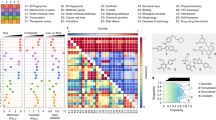Abstract
Chemical genomics is a new research paradigm with importantapplications in drug discovery. It links genomic targets withsmall-molecule chemistries thereby allowing for efficient targetvalidation and lead compound identification. ACADIA'schemical-genomics platform consists of a large and diverse small-moleculelibrary (800,000), a reference drug library (2,000), druggablegenomic targets (>300) and a cell-based functional assaytechnology (R-SATTM; Receptor Selection and AmplificationTechnology) that allows for ultra-high throughput screening(>500,000 data points/week) as well as high throughputpharmacology and profiling over a wide range of targets. Twoexamples are presented that illustrate the success of ourchemical-genomics approach: (i) The validation of inverse agonismat serotonin 5-HT2A receptors as an antipsychotic mechanismand the subsequent discovery of potent and selectively acting 5-HT2A inverse agonists, currently in preclinical development,and (ii) the discovery of the first ectopically binding subtype-selective muscarinic m1 agonist.
Similar content being viewed by others
References
Caron PR, Mullican MD, Mashal RD, Wilson KP, Su MS & Murcko MA (2001) Chemogenomics: a gene family approach to parallel drug discover. Drug Discovery World 2: 57–62.
Croston GE (2002) Functional and Cell-Based uHTS in Chemical Genomic Drug Discovery. Trends Biotech 20:110–115.
Debouck C & Metcalf B (2000) The impact of genomics on drug discovery. Ann Rev Pharmacol Toxicol 40: 193–207.
Drews J & Ryser S (1996) Innovation deficit in the pharmaceutical industry. Drug Info J 30: 97–107.
Drews J (2000) Drug discovery: A historical perspective. Science 287: 1960–1964.
Eglen, ME, Choppin A, Dillon MP & Hegde S (1999) Muscarinic receptor ligands and their therapeutic potential. Curr Op Chem Biol 3: 426–432.
Harris S & Foord SM (2000) Transgenic gene knock-outs: functional genomics and therapeutic target selection. Pharmacogenomics 1: 433–443.
Lander ES et al. (2001) Initial sequencing and analysis of the human genome. Nature 409: 860–921.
Landro JA, Taylor ICA, Stirtan WG, Osterman DG, Kristie J, Hunnicutt EJ, Rae PMM & Sweetnam PM (2000) HTS of the new millennium. The role of pharmacology and flexibility. J Pharmacol Toxicol Method 44:273–289.
Lenz GR, Nash HM & Jindal S (2000) Chemical ligands, genomics and drug discovery. Drug Discovery Today 5: 145–156.
Messier TL, Dorman CM, Brauner-Osborne H, Eubanks D & Brann MR (1995) High throughput assays of cloned adrenergic, muscarinic, neurokinin, and neurotrophin receptors in living mammalian cells. Pharmacol Toxicol 76: 308–311.
Pandey A & Mann M (2000) Proteomics to study genes and genomes. Nature 405: 837–846.
Spalding TA, Trotter C, Skjærbæck N, Messier TL, Currier EA, Burstein ES, Li D, Hacksell U & Brann MR (2002) Discovery of an Ectopic Activation Site on the m1 Muscarinic Receptor. Mol Pharmacol 61: 1297–1302.
Szymkowski DE (2001) Too many targets, not enough target validation. Drug Discovery Today 6: 397.
Triggle DJ (2000) Pharmacological receptors: a century of discovery – and more. Pharm Acta Helv 74: 79–84.
Venter JC et al. (2001) The Sequence of the human genome. Science 5507: 1304–1351.
Weiner DM, Burstein ES, Nash N, Croston GE, Currier EA, Vanover KE, Harvey SC, Donohue E, Hansen HC, Andersson CA, Spalding TA, Gibson DFC, Krebs-Thomson K, Powell SB, Geyer MA, Hacksell U & Brann M (2001) 5-Hydroxytryptamine2a Receptor Agonists as Antipsychotics. J Pharmacol Exp Ther 299: 268–276.
Willson TM, Jones SA, Moore JT & Kliewer SA (2001) Chemical-genomics: Functional analysis of orphan nuclear receptors in the regulation of bile acid metabolism. Med Res Rev 21: 513–522.
Wood MD, Murkitt KL, Ho M, Watson JM, Brown F, Huner AJ & Middlemiss DN (1999) Functional comparison of muscarinic partial agonists at muscarinic receptor subtypes hM1, hM2, hM3, hM4 and hM5 using microphysiometry. Br J Pharmacol 126: 1620–1624.
Author information
Authors and Affiliations
Corresponding author
Rights and permissions
About this article
Cite this article
Hacksell, U., Nash, N., Burstein, E.S. et al. Chemical genomics: massively parallel technologies for rapid lead identification and target validation. Cytotechnology 38, 3–10 (2002). https://doi.org/10.1023/A:1021169023731
Issue Date:
DOI: https://doi.org/10.1023/A:1021169023731




